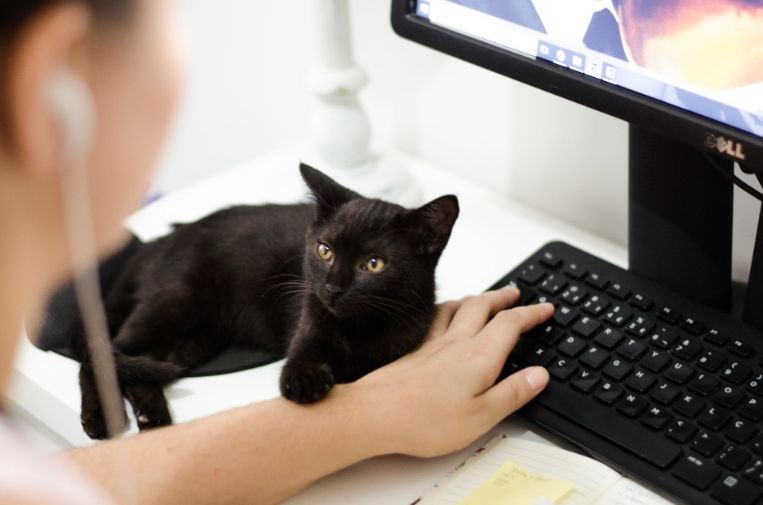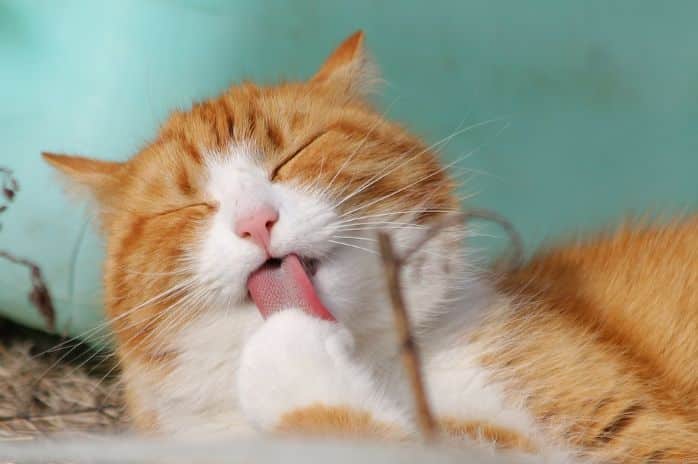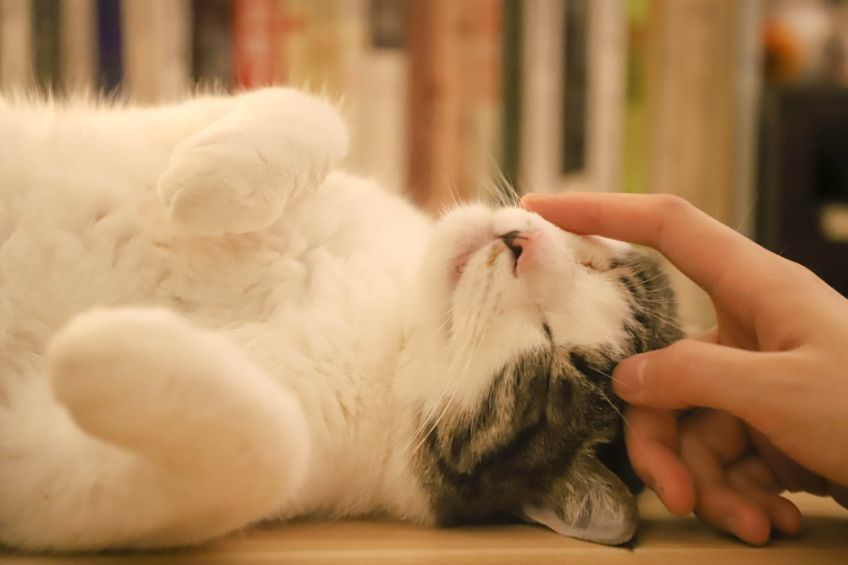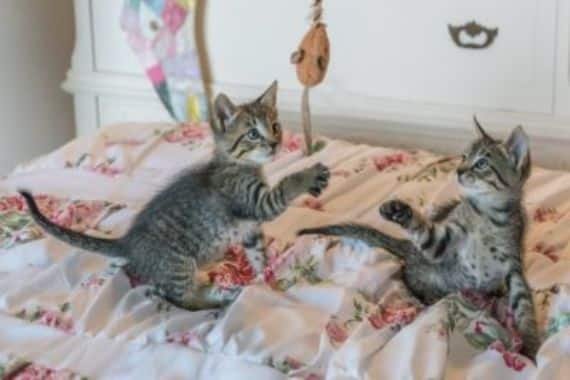We're an affiliate
We hope you love the products we recommend! Just so you know, we may collect a share of sales or other compensation from the links on this page at no additional cost to you. Thank you if you use our links, we really appreciate it!
As pet parents, we all want the best for our cats. But how do we know if they are happy?
The second most popular choice for pets is cats. According to statista.com, it is estimated that approximately 47% of pet owners in the US have cats as pets.
Many cat owners admire their cats for their loyalty, independence, and adorableness. There may be times when they act mischievously, spend their days sleeping in a corner, or push things off your table, but for cat parents, this is a beautiful part of owning a cat.
They might consider a cat’s mood swings to be the most lovable part of taking care of them.

Speaking of mood swings, a cat parent should know when their cat is happy, sad, or anxious. Cat parents need to read the body language and behavior of their feline furballs to understand what should be done or not done.
15 Signs Your Cat is Happy
Here are the 15 signs that show that your cat is happy:
1. Happy cats have sparkling eyes
A cat’s eyes are the window to their emotions. A cat that is feeling happy will have half-closed, relaxed eyes. You should also check if your cat’s blink pattern is slow, which means they are feeling comfortable and unthreatened.
2. They love licking themselves
When cats lick themselves, it means they are cleaning themselves. Animal behavior experts have found that licking releases endorphins in the cat’s brain, giving them an emotional boost. It is a telltale sign that a clean cat is a happy cat.

3. Sleepy Cats
A cat should have a consistent sleeping schedule and sleep pattern. Always monitor your cat’s sleeping habits and make sure they are normal and not constantly changing.
4. They’re friendly
A happy cat will not hesitate to play with its cat parent. They enjoy sitting in their owner’s lap or simply being near them. Some nights, they enjoy snuggling up with their owner in bed.
5. Purring
A cat making a low, soft purr means they are happy and stress-free. If your cat purrs while nestling with you on the couch, it’s likely a sign that she’s happy and content.
6. Healthy
Your cat needs to have regular checkups with your vet. A healthy cat means they are happy and contented. Cats get sick if they are constantly under stress.
7. Good appetite
If your cat can always finish its food, it is a sign that they are in a good mood. An anxious cat will have no interest in eating as they are too focused on other things.
8. Head rubs
A cat in a good mood loves to rub their head against their cat parent. At times, they will even give head rubs to any object in their path, including your legs. Often, they rub against our legs to get our attention, particularly at feeding time.
9. They’re playful
Playing alone does not always mean your cat is lonely. Cats consider their toys their friends, so technically, they are playing with a friend. A happy cat will tend to become playful with other cats or with their owner.
10. They are relaxed
A relaxed cat is free from stress and anxiety. As mentioned before, a cat relaxes by showing a stretched-out body and a tail pointed upwards.
11. They are happy to see you
If you leave your cat at home for some time, a happy cat has a strong tendency to miss you. Once you arrive home, they will approach you and rub their head between your legs, which is an invitation to pet and play with them.
12. They are curious about their surrounding
The saying “curiosity killed the cat” is not valid for a happy cat. You know your cat is satisfied if they seem to enjoy taking some time to understand their environment and show interest in their surroundings.
13. They use the litter box
Believe it or not, a happy cat loves using the litter box. They feel contentment and pride once they have used their litter box, unlike untrained cats. With a contented cat’s confidence in using a litter box, it is essential to clean it regularly.
14. Exposing the belly
A cat exposing their belly shows that they are happy to be petted and given belly rubs. Always remember the other visual cues before approaching your cat in a belly-up pose.
15. Tail Position
If a cat is walking or standing with their tail in an upright position with a slightly bent tip, it indicates that they are happy and relaxed.
How to Keep Your Cat Happy
Now that we have found out the signs that our cats are happy, how can we keep them that way?
1. Provide them with a variety of cat toys to keep them amused
Having toys that your cat can play with and scratch satisfies their primal need to hunt. This will keep their minds engaged and give them satisfaction.
It is advisable to also get a scratching post to help them maintain healthy claws or a cat tree where they can sleep or play.

2. Give them some time outside the house
Cats are curious animals, and after some time, the interior of your home may bore them. Some cats enjoy going outside of their usual territory and exploring the outside world.
Take them out to your garden so they can experience different surroundings. Make sure to keep an eye on them, as they might wander off.
3. Buy them the best cat beds for the best sleep of their life
Offer them a hammock or a castle-like cat house for sleeping. Cats generally need 10 to 15 hours of sleep a day and love to curl up anywhere, from a sunny spot to a random box or even on your laundry pile.
4. Provide them with healthy food and plenty of clean water
A healthy feline is a happy kitty. Feeding them quality food and special treats will keep their teeth healthy, fur coats shiny, and their digestive system free of health problems.
Avoid feeding cats food meant for humans, as many spices and additives are dangerous to them. Cow’s milk, for example, may sound like a cat’s favorite drink, but cats cannot adequately digest it.
Consider getting them a water fountain, as cats prefer running water.
5. Give them the tender, loving care they deserve
Show your love and care through how you interact with your cats and how you respond to them. A cat will stay happy with an ethical and responsible cat parent.

We hope that this article has helped you to find out the signs of a happy cat. What makes your cat the happiest? Comment down below!
Laura is the founder of Furs'n'Paws. She is a also a pet writer and expert with more than 20 years of experience of working with dogs and cats. She developed a very strong love for animals at a young age. Her passion led her to establish a thriving pet sitting and dog walking business in Dubai. As an expert in pet training, behavior, and nutrition, Laura is committed to helping pet owners and pet lovers by offering high-quality information on a wide range of topics.



No responses yet